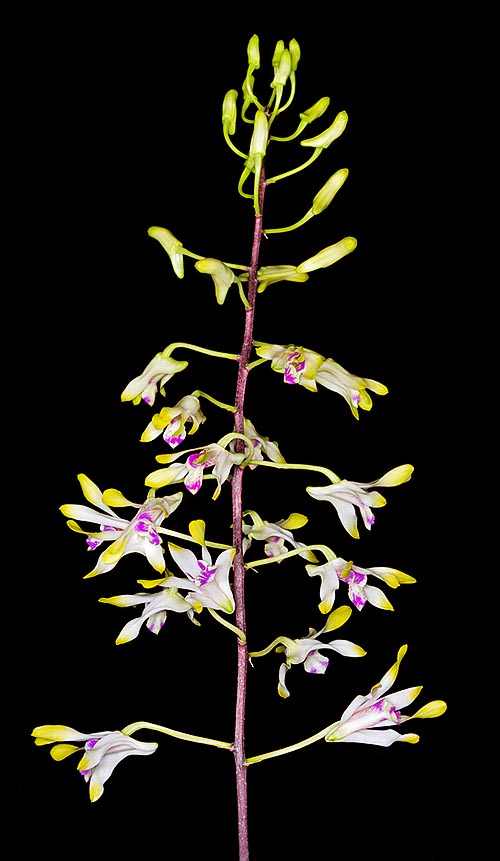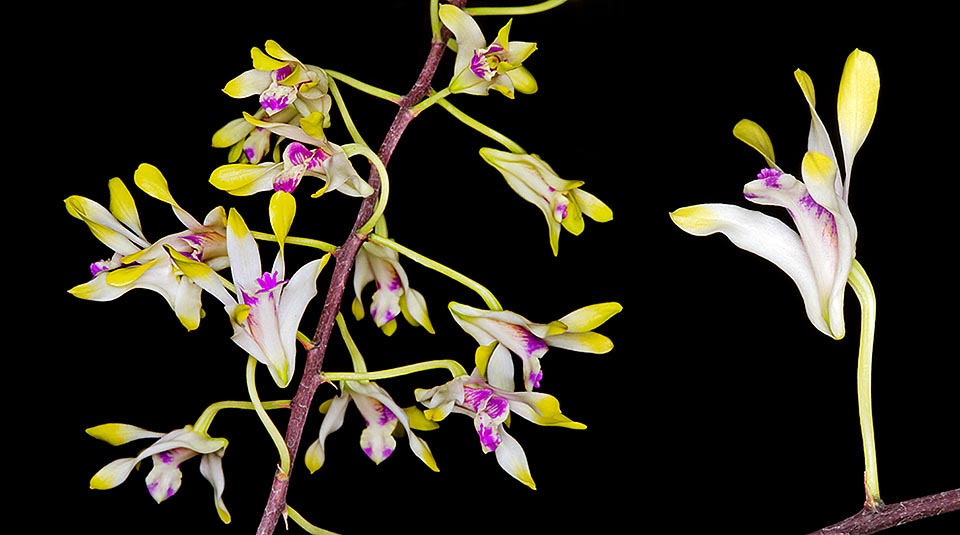Family : Orchidaceae

Text © Pietro Puccio

English translation by Mario Beltramini

Dendrobium canaliculatum grows in Australia and New Guinea © Giuseppe Mazza
The name of the genus is the combination of the Greek substantives “δένδρον” (dendron) = tree and “βίος” (bios) = life, with reference to the numerous species of the genus living on the trees; the name of the species is the Latin adjective “canaliculatus, a, um” = concave, grooved, with reference to upper page of the leaf.
Common names: onion orchid, tea-tree orchid (English).
The Dendrobium canaliculatum R.Br. (1810) is a very variable epiphytic species with fusiform, 5-12 cm long, pseudobulbs of 1,5-3 cm of diameter, provided with 2-6 persistent linear leaves with pointed apex, semi-cylindrical, grooved above, fleshy, 4-16 cm long and 0,5-1,2 cm broad, of dark green colour.
Racemous inflorescences from the upper nodes of the new and old pseudobulbs, 10-40 cm long, erect or arcuate, carrying numerous flowers of 2-3 cm of diameter with linear partially twisted sepals and petals, about 1,5 cm long and 0,3 cm broad, of white colour in the lower half, greenish yellow to bronze or brown in the upper one; the lateral sepals, merged at the base of the column, for a sort of a conical, 0,5 cm long, projection (mentum).
The labellum is trilobed, white with purple violaceous venations, 1-1,5 cm long and 0,8 cm broad, with oblong erect lateral lobes and sub-rounded central lobe with pointed apex rune by three waved and crested lamellae.
It reproduces by seed, in vitro, and division, to be done at the time of the vegetative restart, with each section provided of at least 3-4 pseudobulbs.
Species with copious blooming which compensates the reduced size of the single flowers, lasting about 3 weeks and intensely and pleasantly perfumed, and that has originated numerous hybrids.
It requires high luminosity, also some hours of direct sun, high temperatures in summer, 25-35 °C, cooler in winter, with lowest night ones not under the 12 °C, and medium-high humidity, 60-70%; fundamental in all seasons is a good and constant ventilation.
The waterings must be regular and abundant during the vegetative period, from late spring to early autumn, almost stopped in autumn-winter, moderate and spaced during the blooming period, from late winter to spring. For the watering and the nebulisations is to be used rain water, from reverse osmosis or demineralised; the fertilizations, duly distributed in way to avoid salts accumulation, are to be done during the vegetative period preferably with hydrosoluble balanced products at low nitrogen content, with microelements, at ¼ of the dosage suggested on the packages.

It's an epiphyte present almost exclusively on plants of the genus Melaleuca. Copious scented blooming © Giuseppe Mazza
The species is reported in the appendix II of the CITES (species whose trade is internationally ruled).
Synonyms: Dendrobium tattonianum Bateman ex Rchb.f. (1865); Callista canaliculata (R.Br.) Kuntze (1891); Callista tattoniana (Bateman ex Rchb.f.) Kuntze (1891); Cepobaculum canaliculatum (R.Br.) M.A.Clem. & D.L.Jones (2002); Cepobaculum tattonianum (Bateman ex Rchb.f.) M.A.Clem. & D.L.Jones (2002).
→ For general notions about ORCHIDACEAE please click here.
